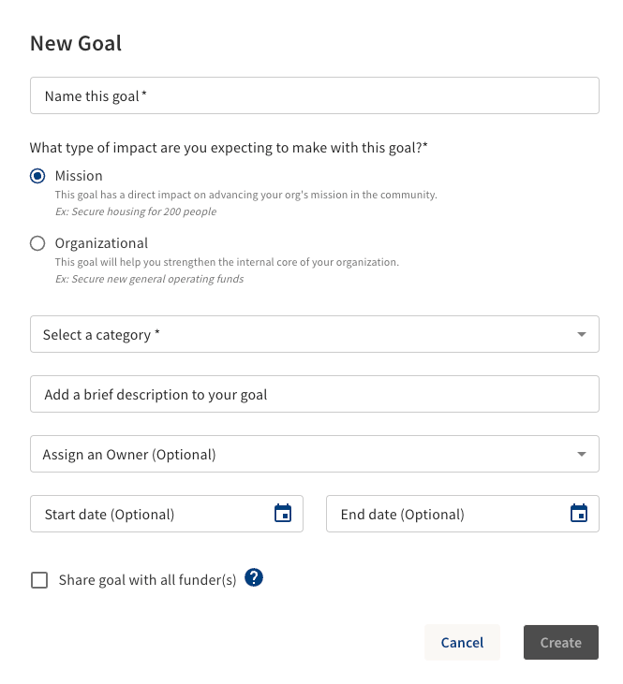Impact Goals: Getting Started with Goals
Use Resilia’s Impact Goals tool to define the outcomes you want to achieve to drive impact toward your mission. Doing so will enable better management and alignment across your organization and programs. Follow these steps to get started:
Your Goals page can be viewed, edited, or added to by anyone on your internal team who has access to Resilia.
Step 1: Add Goals
A goal represents a strategic outcome that your organization aims to achieve to drive your mission. In the Impact Goals tool, you have the option to add one or more goals for your nonprofit.
Consider setting a timeline for each goals to establish a clear target for accomplishment.
Goals are measurable outcomes that act as stepping stones toward reaching your larger impact. Each goal should have specific activities, updates and progress that measures how close you are to achieve those outcomes.
Set goals to define markers of success for your team and more easily measure the impact you're making.
Ways of creating goals
With Resilia you have two ways to add goals to your vision.
- Use the Goal Template Library.
- If you're unsure where to begin, Resilia offers a library of goal templates specifically designed for Capacity Building. These templates have been curated by Resilia nonprofit experts.
- These templates cover various areas such as Board Management, Volunteer Management, and Fundraising, among others.
- By selecting a template, you can set goals to enhance your organization's knowledge and competence in specific areas, helping your team become more proficient in day-to-day operations.
- Simply choose a template, assign tasks, and embark on a learning journey to achieve your goals.

- Add a Goal out of scratch.
- If you already have a clear understanding of what your nonprofit needs to accomplish, you can opt to create a goal from scratch.
- Using the Goal creation modal, you can define the timeline for your goal and assign responsibilities to team members.
- This approach allows you to tailor the goal according to your organization's unique requirements and priorities.
- Once the goal is created, you can begin generating tasks and assigning them to team members to work towards achieving the desired outcomes.

Step 2. Categorize your goals
Categorize your goals for better organization and clearer connection for the area of impact this goal is driving.
Select from: Mission Driven, Internal Capacity, Fundraising, Storytelling, or Other.
Note. If you created a goal from a template, it will get automatically categorized.
Step 3. Assign team members to keep track of progress made
Assign individual team members to own updating the progress of each goal to ensure accountability, collaboration, and communication toward this outcome.
By default, goals are assigned to all team members; you can customize the assignment while adding or editing a goal.
When a goal is assigned to an individual team member, they’ll be notified of this assignment via email.
Step 4: Make your goals measurable
Adding a Progress Chart to your goal enables you to track quantitative progress toward desired outcomes.
Here, you can define the specific targets and metrics that you and your team will focus on.
Consider measuring goals across multiple dimensions, such as different populations or segments, to provide a more in-depth and comprehensive understanding of your impact.
If you already have some progress towards a goal, you can set a starting value to accurately track progress from a specific point.
Examples of Goals
Here are some examples of goals:
Template Goal: Create a detailed strategic plan document outlining specific goals, and action plans for the next three years by the end of the second quarter
- Update 1: Completed our strategic plan for 2024
- Update 2: Have clarity on our year main activities to accomplish our fundraising strategy
Goal: Increasing the number of underserved students enrolled in sports.
- Update 1: Reaching 90% participation in sports programs.
- Update 2: Achieving a 50% increase in the number of underserved students participating in sports.
Goal: Increasing childhood literacy in elementary school children.
Update 1: Reaching an 80% overall classroom grade average of a B+.
Update 2: Ensuring a 20% increase in the number of children reading at or above grade level.
- Progress Chart Dimensions: 1st grade, 2nd grade, 3rd grade
Remember that goals should be tailored to your organization's specific mission and desired impact.
By following these steps, you can leverage Resilia's Impact Goals tool to define, track, visualize, and share your progress toward driving meaningful impact, and facilitate better management and alignment across your organization and programs.
If you have any questions, please contact our customer success team at success@resilia.com.
.png?width=2726&height=680&name=Resilia_Final_Color%20(1).png)